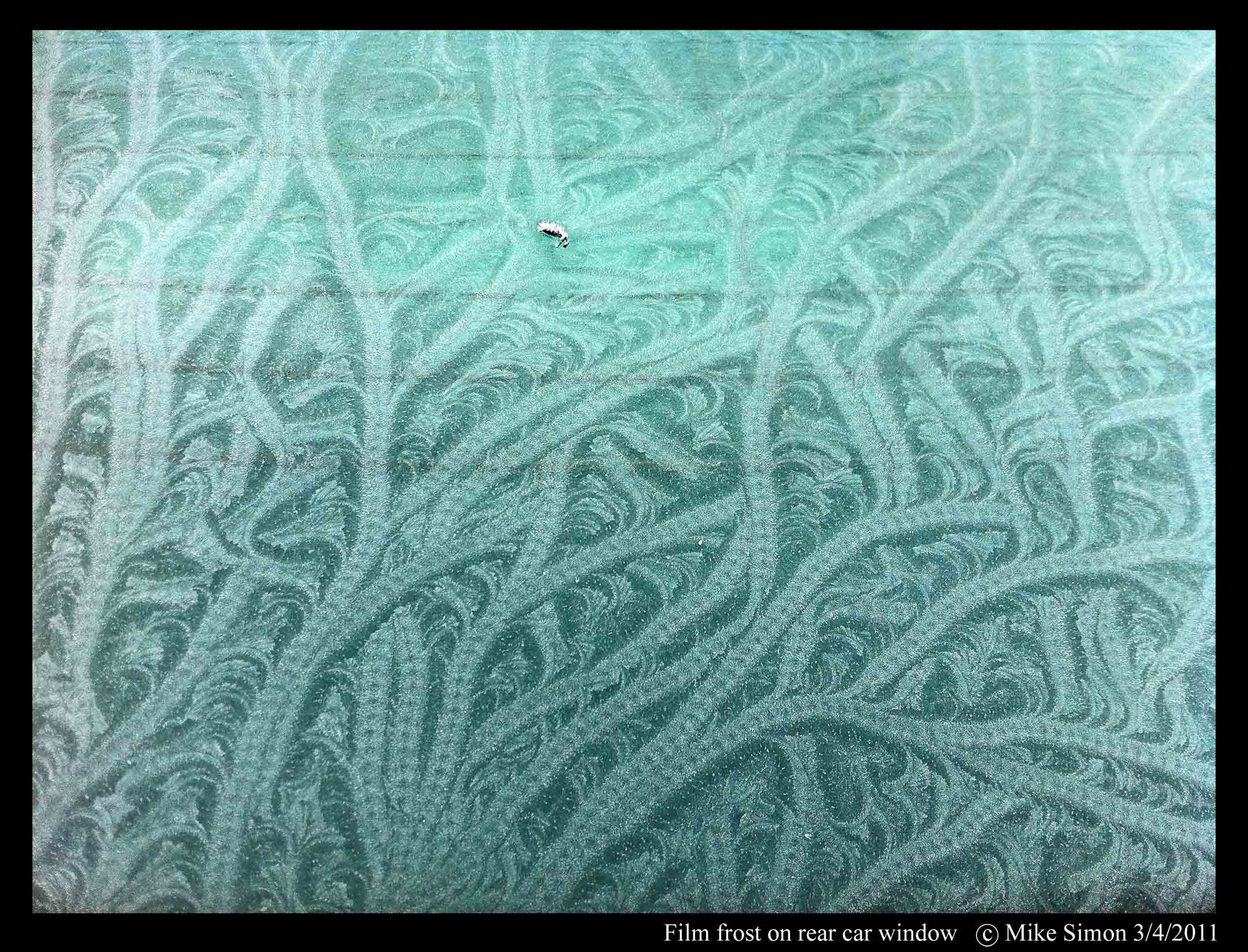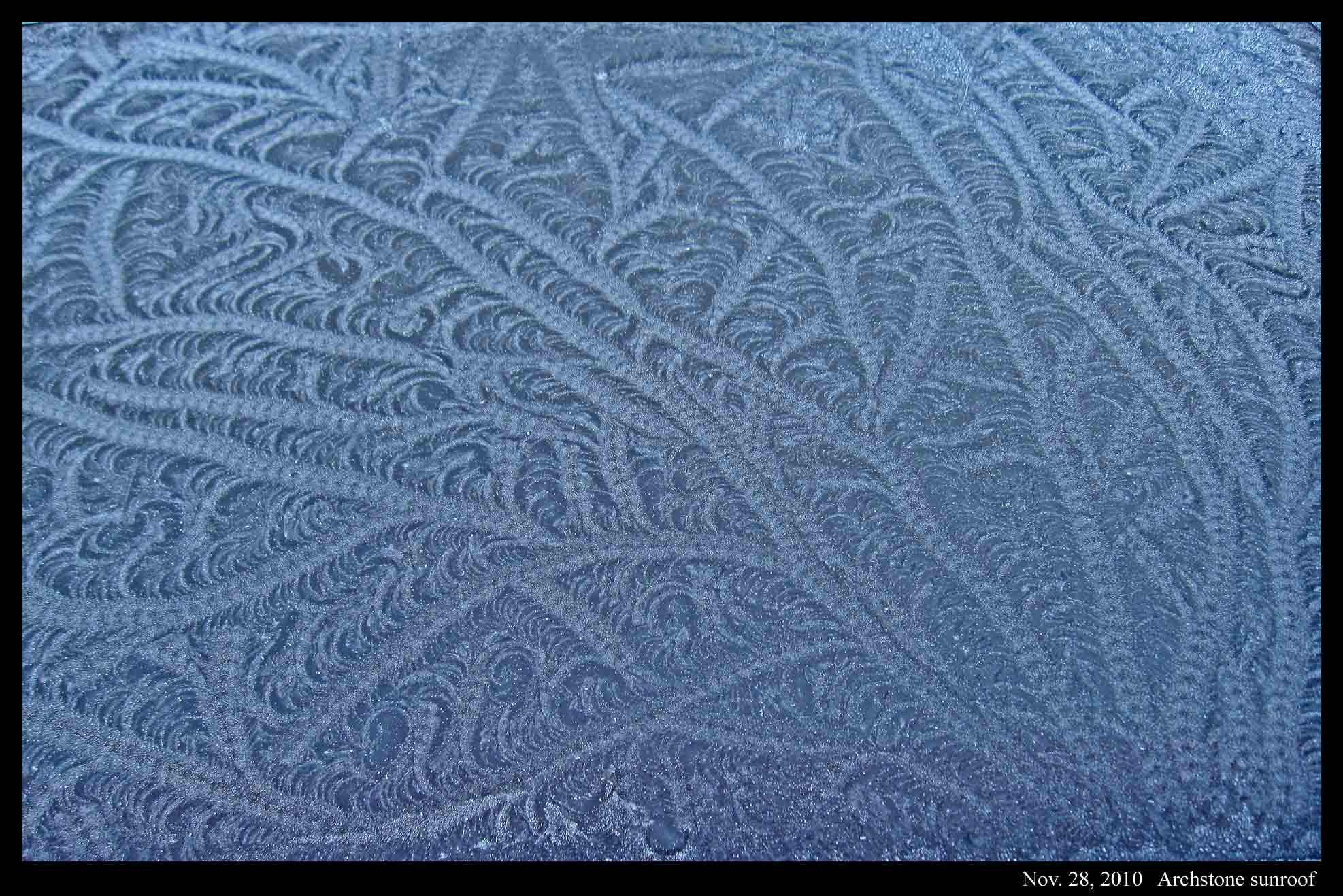Category: "Film frost"
What We Sometimes Miss
March 8th, 2011For the first few years in which I would excitedly go out on frosty mornings to photograph ice formations, I never paid any attention to frost on car bodies. Sometimes I would notice something on our car window, but that was basically it – I was essentially blind to ice in places where I didn’t expect to see anything interesting. Then one day, while returning from an area that often had fascinating puddles and ground ice, I walked next to a black car with the most stunning display of frost that I had ever seen. The car was completely covered roof, hood, and trunk with a thick, large, curvy white pattern of ice made distinct by the background of black underneath.
I spent the next hour or so taking pictures, returning home once to get another camera when my roll of film ran out. Though I understood roughly the processes involved, the initial freezing of a thin layer of water, making curvy ice patterns, followed by vapor depositing onto the frozen parts as hoar, making the ice white, there were other puzzling things that kept me entertained. However, the most puzzling thing of all was the fact that people would walk right by without even slowing down. Here was a strange and rare sight: strange because of the hastily dressed man (myself) leaning over a parked car with a tripod snapping pictures, and a rare yet striking display of curving frost in full view, and yet they paid me nor my prize no mind. It was as if I was the only person who could see the pattern.
The reverse thing happened to me just a few days ago. We had wet weather one day followed by a cold, clear night – perfect conditions for good hoary film frost. And indeed, many cars in our parking lot had beautiful curvy film-frost. I walked around, looking specifically for black cars, which show the most contrast to the white hoar, and photographed some on one car, but somehow overlooked the most amazing one of all: a speckled-seaweed-like pattern that I've seen only once before (see the Dec. 1 posting).
Even though the above was on a black car in a region I checked, I still missed it. But luckily, my neighbor caught it and emailed a few photos. In the image, some of the trails seem to cross over each other, but closer inspection instead suggests a coincidental merging of two trails on one side with a forking off on the other side.
More Tales of Mystery and Observation
December 1st, 2010When I stepped out early Saturday morning, the air seemed relatively warm, particularly compared to the cold snap we had last week. Indeed, it was much warmer, and yet the parking lot in our apartment complex had a glaze that was much more dangerous than that during the cold snap.
But it was the frost that I noticed. Of course, the air was relatively warm, but the clear sky cooled the surface. Recently, snow melted, leaving plenty of open water to evaporate – perfect conditions for film frost and hoar.
I saw “striped-tail” film frost(1) on two car roofs, both times on the sunroof glass. Why only on the glass? Perhaps the glass, being a poorer conductor of heat, had a lower surface temperature. This lower temperature would have produced a thicker film of water, and the thickness of the film seems to influence the pattern. The bigger mystery though is the cause of the pattern. In a short online article(2) last year, I suggested a cause for the stripes on each tail, though I can offer no explanation for either the nearly uniform width of the tails or the meandering. In the case below, the pattern is dense with lazily wandering striped tails. When I look at it, I think of seaweed. The metal car surfaces often had nice curving film-frost with dense hoar, while others had or condensed droplets with more isolated, spiky hoar. The latter appeared on my own car.
The Window of Many Cacti
February 14th, 2010The resemblance may be a bit more obvious in the following shot, which I took two years ago on seeing this form for the first time.
Ripples
February 5th, 2010When there is no pebble tossed
No wind to blow
--Grateful Dead “Ripple”
I don’t know where to start on this one. For some time I’ve been seeing concentric circular patterns on car windshields and car bodies – bands of white spreading out from a central point like ripples in a pond from a tossed pebble. Typically, they spread outward 3-10 inches or so before meeting up with ripples originating from another spot.
When I try to zoom in on the individual crystals, I usually see only vague outlines with the occasional recognizable form. What could cause this pattern? Here's a clue.
Mystery of Whirlpool Hollows
February 3rd, 2010The hollow columnar crystals are oriented lengthwise along concentric circles, which strongly suggests that an underlying film froze with the same rotating crystal orientation. This is strange. To see why I think it strange, we need to specify crystal direction. Consider the ice-crystal optic axis, the length-wise direction of the columns (or the direction straight into a stellar-star crystal). If we draw the optic axis for each crystal as an arrow, then we would have something like the following picture.
When a film of water on a smooth surface like glass or a car roof freezes, the preferred crystal orientation is that with the arrow pointing straight up and out of the surface. So, I find the above pattern mysterious - why don't the arrows have any trend toward pointing upward? Why do all the arrows stay in the same plane? Another mystery is the fact that I’ve seen this same whirlpool pattern with about the same center spot on both side mirrors on more than one morning. Perhaps the whirlpool pattern arises somehow because the surface is curved. Or maybe films of water on plastic freeze differently than films on smooth metal or glass. For now, I’ll call this the mystery of whirlpool hollows.
- JN








